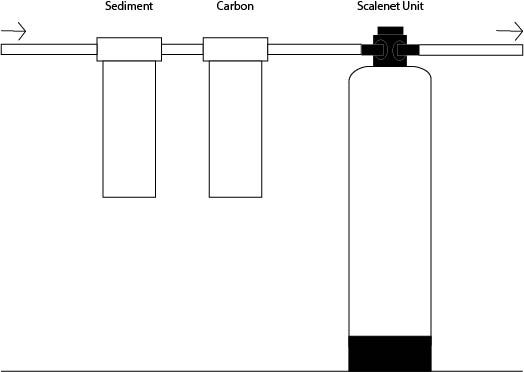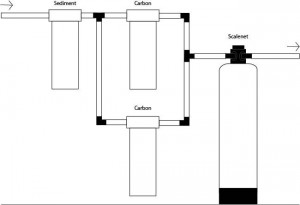Whole House Water Treatment: Keeping It Simple and Easy
Simple whole house treatment for city water consists of a sediment filter, a carbon filter, and a TAC scale prevention unit.
One of the best-kept secrets about water treatment equipment is that to be effective it does not have to be complicated, expensive, and large. The truth is that much of the innovative energy of water treatment professionals in recent years has been directed toward greatly improved performance of traditional items like filter cartridges and toward the development of technologies that provide simpler solutions to problems like scale prevention.
Filter cartridges for city water applications, because of improved efficiency, often outperform large tank-style systems. Similarly, recently developed alternatives to conventional water softeners, like TAC units, can greatly improve water quality and prevent scale buildup without complicated control programming, drain connections, salt purchases, or service agreements.
It is easy to be impressed by the size of a large tank-style whole house carbon filter and to assume that because it is big it works better than a filter that is relatively small. Looks can be deceiving. Compact filter cartridges, made from very tightly packed powdered filter carbon, actually follow a different set of rules than large filters. Concepts like “empty bed contact time” used to design and to size tank style filters filled with granular carbon do not apply to modern filter cartridges. In many ways a well- engineered 4.5″ X 20″ carbon block filter cartridge can outperform a carbon tank with several cubic feet of granular carbon.
Here are some advantages of cartridge-style whole house filters as compared with large tank-style backwashing units:
Easy to install. No drain or electrical connection needed. Thus, fewer plumbing connections, no wiring, and greater flexibility in choosing a place to install.
Low purchase price. Typically, a cartridge filter array costs less than 1/2 as much as a tank-style equivalent.
Easy to service. With cartridge units there is little that can go wrong, so an easy cartridge change and an occasional o ring replacement are all that’s needed. Changing a cartridge is a much easier “do it yourself” job than rebedding a tank-style filter.
Versatile. There are many cartridges to choose from. When you put in a new cartridge, you have a new water filter. If your city changes its disinfectant from chlorine to chloramine, you just change your filter cartridge. If you have a standard-sized filter housing, which is what we recommend, you have literally dozens of cartridges to choose from.
Perhaps the greatest mark of versatility is the ability to easily increase filter capacity by installing two or more carbon filters in parallel, so that each cartridge gets a fraction of the service water. If your cartridge supports a service flow of six gallons per minute, installing a second in parallel gives you twelve per minute. The extra carbon unit(s) can be added at the time of the initial installation, or later, to accommodate an increase in family size or other expanded need for filtered water.
Two carbon cartridges in parallel double the capacity and greatly reduce pressure drop. The multi-cartridge system provides higher flow rates for larger homes.
For scale prevention, passive TAC systems are becoming a popular substitute for conventional water softeners. TAC units require no drain connection and no electricity. The only upkeep is an easy media change, recommended for every three years.
The products featured on this page do not require electricity, drain connections, chemicals, or even water for regeneration. There are no electronic controls to program, no manuals to study, no salt to buy, no brine tanks to clean. Annual filter service is so easy most homeowners can do it themselves. Even the media change in the TAC tank (recommended every 3 years) does not require special equipment or great technical know-how.
More information about cartridge-style whole house units and salt-free scale treatment:






